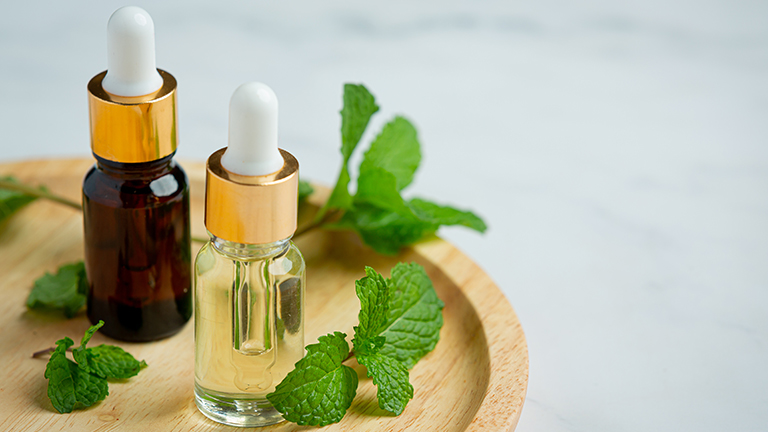Peppermint is a hybrid plant made from water mint and spearmint, with the scientific name Mentha × piperita. It has aromatic leaves containing menthol, which has cooling and pain-relieving properties. Peppermint is often used as an essential oil, in teas and for natural health for digestion and headaches/migraines.
Acquaintance
Migraines are more than just headaches — they are complex neurological conditions that can cause throbbing pain, sensitivity to light, nausea, and fatigue. For many, traditional medications do not offer consistent relief. That is when natural remedies like peppermint oil for migraines come into play, and are a safe, cost-effective, and science-backed option.
Peppermint oil comes from the Mentha × piperita plant and is rich in menthol, a compound known for creating a cooling sensation and its analgesic properties. When applied correctly, peppermint essential oil can relieve tension related to headaches, help muscles relax, and improve circulation – providing a natural way to treat migraines.
What Is Peppermint Oil?
Peppermint essential oil is derived from the peppermint plant’s leaves through steam distillation. This oil contains active compounds including menthol, menthone, and limonene, which provide peppermint oil with its unique therapeutic qualities. For hundreds of years, peppermint oil has been included in traditional medicine for digestive support, sinus congestion relief, pain relief, and headaches.
Today, peppermint oil is widely used in aromatherapy and as an option for natural pain management, especially for those seeking a non-pharmaceutical solution. Its cooling effect is immediate in providing comfort and relaxation when applied to the temples, or inhaled.
The Science Behind Peppermint Oil and Migraines
1. The Mechanism of Action of menthol to Relieve Migraine Pain
Menthol, an ingredient of peppermint oil, is thought to act on the cold-sensitive TRPM8 receptors in skin to provide a cooling effect that provides a blockade of pain signals. This mechanism may help relieve the inflammation and muscle tension often seen with migraine headaches.
2. Evidence from Clinical Studies on Peppermint Oil
Several clinical studies provide evidence to support the use of peppermint oil for headache relief. A 1996 study published in Cephalalgia investigated a topical application of menthol gel (10%) and found that it provided similar relief from tension-type headaches, language in the study suggests measuring headache severity, to taking 1,000 mg of acetaminophen (Tylenol). A more recent study published in 2010 measured the headache severity after applying menthol gel (5% and 10%) to the temples and found decreased headache severity in 15 minutes compared to sham treatment group.
3. Neurological Effects
Menthol might help modulate cerebral blood flow and suppress nerve excitability, both of which indicate an inflammatory component involved in the triggering of migraine headache. Menthol also has some effect of relaxing muscle and vasodilating blood vessels and might aid in relieving the muscle contraction of blood vessels involved in migraine pain.
4. The Role of Aromatherapy
Inhaling peppermint oil vapor or diffusing peppermint oil in a room may help relax the central nervous system and reduce migraine induction in response to stress. Aromatherapy functions by stimulating the olfactory system, informing brain regions involved in emotion and pain processing.
How to Use Peppermint Oil for Migraine Relief
Proper use of peppermint oil is critical to receiving its full benefits. You can use peppermint oil to relieve migraines in the top three ways:
1. Topical use through temple massage
Combine 2-3 drops of peppermint essential oil with a carrier oil, like coconut or jojoba oil, and massage onto your temples, forehead, and back of your neck. Within minutes, the peppermint oil will help relax muscles and relieve tension.
2. Aromatherapy through inhalation
Add 5-10 drops of peppermint essential oil to a diffuser and take deep inhalations, or place a few drops on a tissue, and inhale. Inhaling the peppermint oil vapors helps decrease nausea, calms your brain and decreases the intensity of a headache.
3. Cooling compress method
Add a few drops of peppermint essential oil to a bowl of cool water, soak a clean towel, wring it out, and lie it across the forehead for 10-15 minutes. This cooling has the effect of relieving migraine pain almost immediately.
4. Peppermint Oil Roller
You can make a peppermint oil roller you can take with you on the go. Combine 10 drops of peppermint oil and 10 drops of lavender oil and 2 Tablespoons of your carrier oil in a 10ml roller bottle. When you are feeling the symptoms of a migraine, apply it to your temples and wrists.
5. Steam Inhalation
If you have a headache related to sinus issues, add 3 drops of peppermint oil to hot water, cover your head with a towel, and inhale the steam for 5 minutes. This will clear your sinuses and facilitate soothing your head.
Key Benefits of Peppermint Oil for Migraines
1. Quick Relief from Pain
Menthol provides fast-acting cooling and analgesic effects to relieve pain quickly. Users often report relief within minutes of application.
2. Reduces Tension and Stress
Peppermint oil is a muscular relaxant. It can reduce anxiety and muscle tension that contribute to tension-type headaches that may precipitate migraines.
3. Increased Blood Circulation
Topical application of peppermint oil increases blood circulation, allowing more oxygen to reach the brain and ultimately relieve constricted blood vessels.
4. Decrease Nausea and Sensitivity
The invigorating scent of peppermint oil can reduce nausea and light sensitivity, which are common symptoms experienced with migraines.
5. Natural Option to Pain Medications
If you are an individual who uses pain relief medications that are mind-altering, peppermint oil is a reasonable alternative, especially for recurring migraines. Peppermint oil is safe, non-addictive, inexpensive, and compared to medications, it is difficult to overdose.
Safety, Risks, and Precautions
While peppermint oil can be used in many contexts safely, it is always best in moderation. Here are some important guidelines:
- Always dilute peppermint oil when you apply it topically or when ingesting it in certain contexts.
- Do not apply peppermint oil near your eyes, mouth, broken skin, or any other damaged surface.
- This oil is not recommended for newborns or very young children.
- Be sure to consult your doctor before using peppermint oil if you are pregnant or breastfeeding.
- You should do a patch test the first time using peppermint oil.
Some possible side effects of peppermint oil are burning, allergic reactions, or respiratory irritation from overdoing it.
Peppermint Oil vs. Conventional Migraine Treatments
Compared to over-the-counter painkillers, peppermint oil offers a holistic approach with fewer side effects.
| Aspect | Peppermint Oil | Conventional Medication |
|---|---|---|
| Relief Type | Natural, topical, and aromatic | Pharmaceutical, internal |
| Onset Time | Within 10–15 minutes | 20–45 minutes |
| Side Effects | Minimal when diluted properly | Gastrointestinal or liver strain possible |
| Cost | Low (long-lasting bottle) | Moderate to high |
Expert Opinion and Research Insights
According to Dr. Lauren Adams, MD, Neurologist at Johns Hopkins Medicine, “Clinical evidence indicates that peppermint oil, specifically the menthol component, provides rapid relief of tension-type headaches and mild migraines.”
“Evidence suggests that peppermint oil provides significant analgesic effects when applied topically using the appropriate 10% menthol concentration due to the response to cooling and vascular relaxation.”
Researchers, including Göbel et al. (1996), in the journal Cephalalgia, demonstrated peppermint oil’s effectiveness in providing headache relief that was comparable to acetaminophen, thereby providing support for the clinical management of migraines.
DIY and Home Remedies with Peppermint Oil
1. Traditional Peppermint-Lavender Migraine Balm-
Combine 10 drops each of peppermint and lavender oils with 2 tablespoons shea butter and 1 tablespoon beeswax. Melt, mix, and store in a small glass jar. Apply to temples when the migraine begins.
2. Traditional Cold Compress Blend-
Mix 5 drops of peppermint oil and 3 drops of eucalyptus oil in a bowl of cold water. Soak a towel in the water and lay on your forehead to help reduce the pulsating with pain.
3. Traditional Migraine Diffuser Blend-
Add 3 drops of peppermint, 3 drops of lavender, and 2 drops of frankincense oil to your diffuser. Inhale the aroma to calm and prevent headaches from occurring.
Frequently Asked Questions (FAQ)
1. How long does it take for peppermint oil to be effective for migraines?
Most individuals report relief within 10 to 20 minutes of topical and/or inhalation use.
2. Can I put peppermint oil on my skin directly?
No. It is best to always dilute peppermint oil with a carrier oil (example: coconut or jojoba) in order to avoid the risk of irritation.
3. Is peppermint oil okay to use while pregnant?
Please reach out to a healthcare provider. Small amounts of peppermint oil is generally okay; however, some essential oils are sometimes avoided during pregnancy.
4. Can peppermint oil be used on children?
No, peppermint oil should not be used on children under the age of 6 due to respiratory issues.
5. Does peppermint oil decrease migraines?
Using peppermint oil regularly for aromatherapy and stress reduction can help decrease the number of migraines one may experience; however, every individual is different.
Conclusion
One of the most effective natural remedies for migraine is peppermint oil. By science and centuries of previous use, menthol, the active ingredient in peppermint oil, has been established as a potent pain reliever for tension and stress. Also, as with many natural substances, it offers a quick, reliable option for migraine relief that does not create long-term dependence on medications.
Used narrowly, topically (inhaled or placed on the skin), or simply blended as part of the oil in a diffuser, peppermint oil is safe and generally effective in the treatment of headache. Used in concert with a healthy lifestyle and discovered stress reduction options, peppermint oil may be added for a powerful migraine remedy.
Choose only therapeutic-grade peppermint oil, consult your health care provider if the headaches are chronic or severe. Consistent use in known technique will provide additional natural balance and support.


